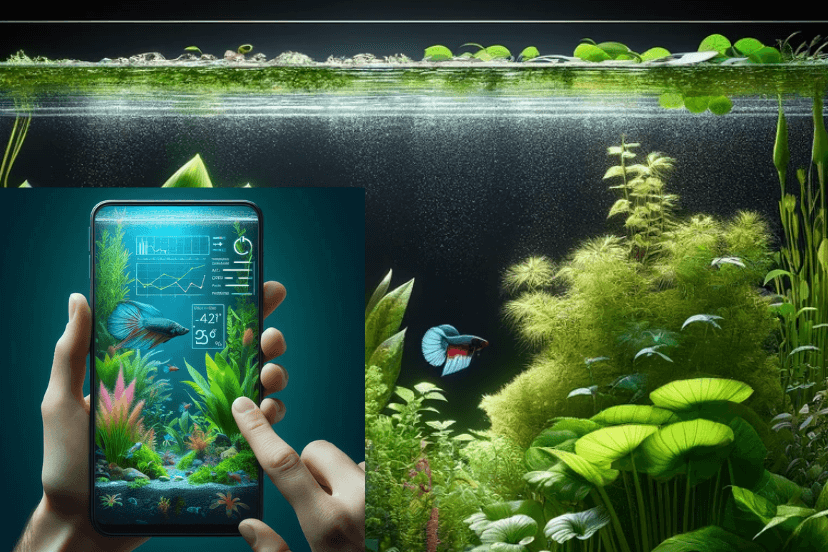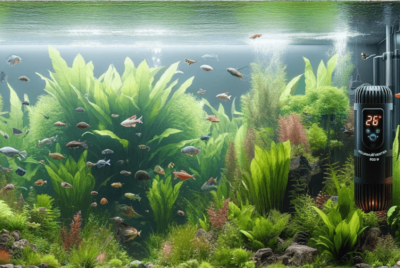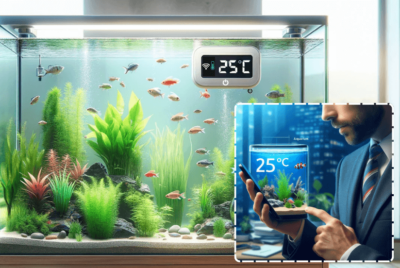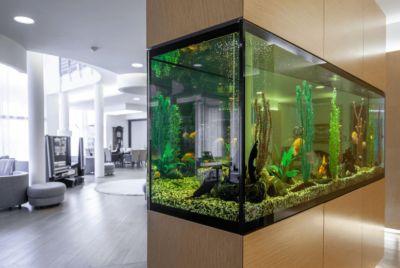Optimizing Aquarium Floater Plants Care with Smart Devices
Aquarium floater plants are not just a decorative element in your aquatic ecosystem; they play a crucial role in maintaining the balance and health of your aquarium. If you’ve ever found yourself pondering the secrets to enhancing the growth and health of these vital plants, you might be surprised to learn that smart devices hold the key. In today’s world, technology has seamlessly integrated into our lives, offering innovative solutions to traditional problems. Let’s delve into how these advancements can revolutionize your approach to aquatic gardening, turning the upkeep of your floater plants into a manageable and flourishing endeavor.
The introduction of smart devices in the care of aquarium floater plants has been nothing short of revolutionary. Imagine having a system that not only automates the essential aspects of care, such as lighting and nutrient supply but also monitors water conditions to ensure they are always optimal for your plants’ growth. This level of control and precision not only makes maintenance easier but significantly enhances the health and vibrancy of your floater plants. Through this exploration, we’ll uncover the myriad ways in which embracing smart technology can elevate your aquatic gardening experience, ensuring your aquarium remains a lush, thriving haven for both your plants and aquatic life. Join us as we journey into the future of aquarium care, where technology and nature harmonize to create the perfect underwater world.
Understanding Aquarium Floater Plants
Understanding aquarium floater plants goes beyond appreciating their beauty; these plants are fundamental to the ecological equilibrium of your aquarium. They are not merely ornamental; they are vital in sustaining your tank’s health. Aquarium floater plants, like Duckweed, Water Lettuce, and Frogbit, offer more than just aesthetic appeal. They excel in purifying the water by absorbing excess nutrients, thus combating algae growth and ensuring clearer water. Moreover, they provide essential shelter and breeding grounds for fish and invertebrates, making them indispensable for a thriving aquatic ecosystem. Their ability to float on the water’s surface allows them to receive ample lighting, which, in turn, facilitates robust growth and oxygen production, further enhancing the water quality and the overall health of your tank’s inhabitants.
Diving deeper into the world of aquarium floater plants reveals a symbiotic relationship between these plants and your aquatic pets. By offering shade, they create a more natural and comfortable environment for your fish, mimicking their native habitats and reducing stress. Additionally, these plants play a significant role in the nitrogen cycle, a critical process for converting harmful waste products into less toxic substances. Integrating floater plants into your aquarium is not just about adding greenery; it’s about embracing a holistic approach to tank management.
As we continue to explore the benefits of these aquatic marvels, it becomes clear that incorporating floater plants into your aquarium setup is a smart move towards a healthier, more vibrant aquatic life. Their low maintenance requirements, coupled with their significant environmental benefits, make them an excellent choice for both novice and experienced aquarists alike, fostering a connection with nature while enhancing the beauty and balance of your aquatic haven.
Types of Popular Aquarium Floater Plants
Navigating through the vast array of floating plants can be overwhelming, but some truly stand out for their beauty, ease of care, and benefits to your aquatic ecosystem. Here are the stars of the show:
Duckweed (Lemna minor)

Duckweed, or Lemna minor, stands out not only for its appealing green coverage but also for its significant environmental benefits within an aquarium setting. This plant’s small, green leaves form a vibrant carpet on the water’s surface, bringing a minimalist yet lush aesthetic to any tank. Beyond its visual appeal, Duckweed excels in nutrient absorption, effectively purifying the water by consuming excess nitrates and phosphates that can lead to unwanted algae growth. Its simplicity, combined with its powerful purifying capabilities, makes Duckweed an excellent choice for aquarists seeking both beauty and functionality in their aquatic ecosystems. Embracing Duckweed means embracing an efficient, natural solution to maintaining clear and healthy water, enriching your aquarium with both charm and ecological balance.
Water Lettuce (Pistia stratiotes)

Water Lettuce, or Pistia stratiotes, brings a unique, soft elegance to any aquarium with its rosette-like leaves that mimic the appearance of a lettuce head. This aquatic plant is not only visually appealing but also serves a functional role within the aquatic habitat. Its roots, which extend gracefully underwater, create perfect hiding places for fish and fry, offering them a sanctuary from the hustle and bustle of tank life. Moreover, Water Lettuce competes with algae for nutrients, effectively reducing algae growth by monopolizing the essential nutrients needed for algae to thrive. This dual benefit of beauty and functionality makes Water Lettuce a popular choice among aquarists looking to enhance the aesthetic appeal of their tanks while simultaneously improving the environmental quality for their aquatic inhabitants. Embracing Water Lettuce in your aquarium setup introduces a piece of aquatic flora that not only beautifies but also harmonizes the ecosystem within your tank.
Frogbit (Limnobium laevigatum)

Frogbit, scientifically known as Limnobium laevigatum, is a delightful addition to any aquarium, with its small, lily pad-like leaves that float serenely on the water’s surface. This plant not only adds a touch of natural beauty but also plays a vital role in the health of your aquatic environment. The roots that hang beneath its leaves act as a natural filtration system, absorbing impurities and excess nutrients from the water, which significantly enhances water quality. Furthermore, these roots provide a secure and cozy refuge for fish and other aquatic inhabitants, promoting biodiversity and a stable ecosystem within your tank.
Incorporating Frogbit into your aquarium introduces a functional yet aesthetically pleasing element, making it a favored choice for aquarists who value both the visual and environmental benefits of their aquatic plants. Its ability to purify water while offering shelter to aquatic life makes Frogbit a natural, efficient, and attractive option for creating a healthier and more inviting aquarium habitat.
Water Hyacinth (Eichhornia crassipes)

Water Hyacinth, or Eichhornia crassipes, is a stunning addition to any aquarium, celebrated for its beautiful purple flowers and substantial size. This aquatic plant not only brings a splash of color and visual interest to your tank but also plays a crucial role in the ecosystem. It excels in absorbing excess nutrients from the water, helping to maintain a balanced environment and reduce algae growth. Furthermore, the broad leaves of Water Hyacinth provide ample shade, creating a cooler and more comfortable habitat for your aquatic inhabitants. However, it’s important to note that Water Hyacinth thrives in warmer conditions, making it a perfect choice for aquariums maintained at higher temperatures. Incorporating Water Hyacinth into your aquarium setup not only enhances its aesthetic appeal but also contributes positively to the health and well-being of your aquatic ecosystem, making it a beloved choice for both novice and experienced aquarists alike.
Salvinia (Salvinia minima)

Salvinia, scientifically known as Salvinia minima, is a remarkable aquatic plant that boasts small, buoyant leaves uniquely designed with tiny hairs to repel water. This fascinating feature ensures that the leaves remain dry, floating effortlessly on the surface. Salvinia serves as an excellent natural tool for moderating light penetration into the aquarium, which is crucial for controlling algae proliferation by limiting the algae’s access to sunlight. Moreover, its swift reproductive abilities allow it to rapidly cover the water’s surface, making it an efficient participant in nutrient absorption.
By soaking up excess nutrients, Salvinia helps maintain the water’s quality, preventing nutrient overload that often leads to unwanted algae blooms. Introducing Salvinia to your aquarium setup not only contributes to a balanced and healthy aquatic environment but also adds a layer of natural beauty with its unique texture and form, making it an ideal choice for aquarists aiming to enhance their tank’s biodiversity while managing light and nutrient levels naturally.
Azolla (Azolla filiculoides)

Azolla, commonly known as mosquito fern, presents a remarkable reddish hue that adds a vibrant splash of color to any aquarium setting. This distinctive plant is highly regarded for its nitrogen-fixing capabilities, which enrich the water with essential nutrients, fostering robust plant growth throughout the aquarium. Azolla’s dense mat formation not only minimizes water evaporation, ensuring a more stable aquatic environment, but also offers much-needed shade, creating cooler, more comfortable conditions for your aquatic residents. Its ability to both beautify the tank and contribute to a healthier ecosystem makes Azolla an invaluable addition to aquariums. By integrating Azolla into your setup, you’re not just adding visual appeal; you’re embracing a natural, efficient way to enhance water quality and provide a better habitat for all your aquarium inhabitants.
Each of these floating plants has its requirements, such as light, temperature, and nutrient levels, but together they contribute significantly to the ecological balance of your aquarium. You can create a beautiful, healthy, and self-sustaining aquatic environment by selecting the right combination of floater plants.
Benefits of Having Floater Plants in Your Aquarium
Introducing floater plants into your aquarium isn’t just about adding beauty; it’s about embracing a host of benefits that can significantly improve the health and appeal of your aquatic environment. Here’s why incorporating these natural wonders into your tank is a smart move:
- Nutrient Cycling: Floater plants are incredibly efficient at absorbing excess nutrients, particularly nitrates, from the water. This process helps in controlling algae growth by removing the nutrients algae need to thrive.
- Temperature Regulation: The natural shading provided by floater plants can help cool the water temperature, creating a more comfortable environment for your aquatic life.
- Stress Reduction for Fish: The shaded areas created by floating plants offer hiding spots for fish, which is essential for their safety and stress reduction. This mimics their natural habitat and helps in maintaining their well-being.
- Aesthetic Enhancement: Floater plants add a lush, green look to your aquarium, transforming it into a vibrant and dynamic ecosystem. Their unique appearance can elevate the overall aesthetic of your tank.
- Improved Water Quality: By adding oxygen and removing toxins, floater plants actively contribute to better water quality. This makes your aquarium a healthier place for all its inhabitants.
Incorporating floater plants into your aquarium setup is a decision that brings multifaceted benefits, from enhancing water quality to providing a visually appealing and stress-free environment for your fish.
The Role of Smart Devices in Modern Aquascaping
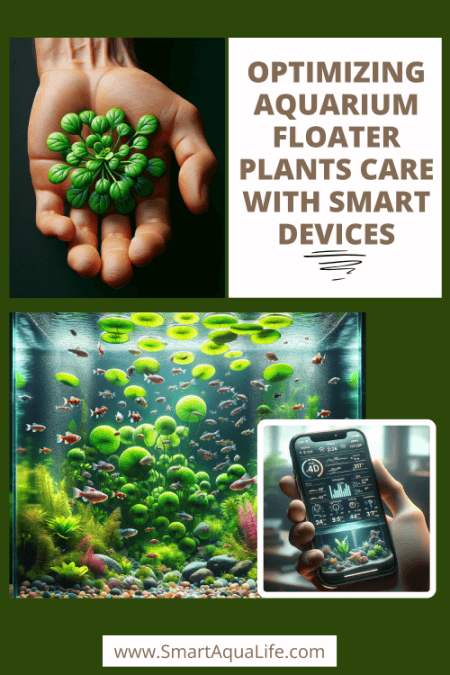
The Role of Smart Devices in Modern Aquascaping has dramatically shifted the landscape of aquarium care and design. Gone are the days when aquascaping was solely about the strategic placement of plants, rocks, and substrates. Now, the integration of smart devices into the aquatic world has ushered in a new era of convenience and precision. These devices, ranging from automated lighting systems that mimic natural sunlight cycles to smart filters that adjust to the tank’s needs in real-time, are transforming our approach to maintaining and beautifying aquatic environments.
Smart heaters maintain optimal water temperatures effortlessly, while CO2 injectors and nutrient dosers ensure plants thrive with minimal human intervention. This evolution in aquascaping tools not only simplifies the hobby but also opens up new possibilities for creating more complex, healthy, and stunning aquatic landscapes. As we delve into the benefits of these smart devices, it becomes clear that technology is not just an add-on but a vital component in elevating our aquascaping endeavors to new heights, making the care of our underwater gardens more effective and enjoyable.
Overview of Smart Aquarium Devices
Smart aquarium devices range from automated feeders and smart lighting to sophisticated water quality monitors and temperature controllers. These gadgets are designed to make aquarium maintenance easier and more efficient, allowing you to focus on the joy of aquascaping rather than the chores.
How These Devices Can Improve Aquarium Care
Smart devices streamline aquarium care by automating routine tasks and monitoring conditions in real time. For example, they can adjust lighting based on the time of day, dispense food at scheduled intervals, and alert you to changes in water quality. This ensures your aquatic plants and fish thrive in a consistently optimal environment.
Optimizing Floater Plant Growth with Smart Lighting
Optimizing floater plant growth with smart lighting is a game-changer in the realm of aquascaping. Light serves as the essential source of energy for all aquarium plants, floaters included, fueling their photosynthesis process and overall health. Traditional lighting often falls short in replicating the dynamic nature of sunlight, leading to suboptimal plant growth. However, smart lighting solutions have revolutionized this aspect by introducing the capability to mimic natural light cycles accurately.
These advanced systems can adjust intensity, color, and duration to closely resemble the sun’s patterns, providing plants with a more natural and conducive growing environment. With smart lighting, aquarists can effortlessly control these settings through their smartphones or automated schedules, ensuring their floater plants receive the ideal amount of light without the guesswork. This not only promotes healthier, more vibrant growth but also enhances the visual appeal of the aquarium, making it a thriving ecosystem. Embracing smart lighting technology is a strategic move towards achieving lush, flourishing aquatic gardens that mirror the beauty and complexity of nature itself.
Importance of Lighting for Aquarium Floater Plants
The role of lighting in the health and growth of aquarium floater plants cannot be overstated. These plants rely heavily on sufficient lighting to drive the photosynthesis process, converting light into the essential energy needed for growth and for oxygenating the water. In the absence of proper lighting, floater plants struggle to thrive, affecting not just their health but also the overall balance of the aquarium ecosystem. Enter smart lighting solutions, designed to mimic natural light conditions perfectly. These innovative systems can adjust the spectrum and intensity of light throughout the day, catering to the specific needs of your floater plants. By ensuring your aquatic plants receive just the right amount of light, smart lighting setups help your floaters not just survive, but truly flourish, enhancing the beauty and vitality of your aquarium.
Types of Smart Lighting Solutions
There’s a smart lighting solution for every type of aquascape. LED lights with adjustable spectrums and intensities can be programmed to simulate natural daylight cycles, including sunrise and sunset. Some models even allow for weather effects, like cloud cover and lightning storms, providing a dynamic lighting experience that benefits both plants and aquarium inhabitants.
Automated Nutrient Delivery Systems for Healthier Plants
Automated Nutrient Delivery Systems for Healthier Plants have revolutionized the care of aquarium floater plants, turning what used to be a guessing game into a precise science. In the dynamic ecosystem of an aquarium, providing your floater plants with the correct balance of nutrients is crucial for their growth and health. Manually managing this balance can be time-consuming and prone to errors. However, with the advent of automated nutrient delivery systems, aquarists can now ensure their plants receive exactly what they need, when they need it.
These systems carefully measure and distribute the right doses of essential nutrients, eliminating the risk of under or overfeeding. By mimicking the natural nutrient availability found in their habitats, these smart systems promote vibrant, robust growth, making your aquatic garden not only healthier but also more visually stunning. This technological advancement is a game-changer, empowering both novice and experienced aquarists to maintain thriving aquatic environments with ease and precision.
The Necessity of Nutrients for Aquarium Floater Plants
Floater plants are not just simple adornments; they require a precise blend of nutrients, including nitrogen for vibrant, lush leaves and potassium for robust growth, to truly flourish in your aquarium. However, delivering these essentials in the right amounts at the right time can be a delicate balancing act. It’s not just about survival; it’s about enabling your floating greenery to thrive and become the centerpiece of your aquatic ecosystem. Automated nutrient delivery systems have emerged as a game-changer, precisely dosing your aquatic garden with the necessary nutrients, ensuring your floater plants receive exactly what they need, exactly when they need it. This technological advancement makes maintaining a lush, vibrant aquarium simpler and more efficient, turning the dream of a thriving aquatic garden into reality.
How Smart Devices Can Manage Nutrient Levels
In the ever-evolving world of aquarium care, smart devices have become indispensable tools for maintaining perfect nutrient levels, eliminating the guesswork from nutrient dosing. These innovative gadgets continuously monitor water conditions, analyzing data in real-time to adjust nutrient levels precisely. This ensures that your aquatic plants receive just the right amount of sustenance to stay vibrant and healthy. Acting as a personal gardener for your aquarium, these devices are dedicated to optimizing the health of your plants, making it easier than ever to maintain a thriving aquatic environment. With smart devices at your service, you can rest assured that your aquatic plants are receiving the best possible care, allowing you to enjoy the beauty of your aquarium without the constant worry of manual adjustments.
Smart Water Quality Monitors for Floater Plant Health
Achieving optimal health for floater plants goes beyond surface-level care, delving into the unseen essence of water quality. The vitality of these plants is intricately linked to the condition of their aquatic environment, where even minor fluctuations in water parameters can impact their growth and health. Smart water quality monitors emerge as invaluable allies in this context, continuously analyzing the water to detect any changes that could signal trouble. By alerting aquarists to shifts in pH levels, temperature, and other critical factors, these devices play a crucial role in maintaining an ideal habitat for your floater plants. With the assistance of smart technology, ensuring your aquatic plants flourish has never been more straightforward or more efficient, allowing you to enjoy a thriving aquarium with peace of mind.
The Impact of Water Quality on Aquarium Floater Plants
Water quality is the foundation of a healthy aquarium. Parameters like pH, ammonia, nitrites, and nitrates can significantly affect your floater plants’ health. Too much or too little of anything, and you may find your plants struggling to survive.
Using Smart Monitors to Maintain Optimal Conditions
Smart monitors act as the vigilant guardians of your aquarium, tirelessly overseeing the aquatic environment to ensure your plants and fish thrive. These advanced tools continuously monitor water parameters, instantly notifying you of any shifts that might pose a threat to your aquatic life. Armed with real-time data, you’re empowered to swiftly respond, making necessary adjustments to water conditions, temperature, and lighting to maintain an ideal habitat. This technology simplifies the art of aquarium maintenance, offering peace of mind and fostering a healthy, vibrant underwater ecosystem where your floater plants and aquatic creatures can flourish. With smart monitors in place, achieving and sustaining optimal conditions for your aquarium is not just possible—it’s effortless, ensuring your aquatic garden remains a thriving haven for all its inhabitants.
Temperature Control with Smart Heaters and Coolers
Temperature control is a cornerstone of healthy aquarium life, especially for delicate plants and fish that thrive within specific thermal ranges. Smart heaters and coolers have revolutionized aquarium care by automating the process of maintaining these crucial temperature settings. With the ability to precisely monitor and adjust water temperature based on real-time conditions, these intelligent devices ensure your aquatic environment remains consistently within the ideal range. This not only promotes the well-being and growth of your aquarium plants but also supports a balanced ecosystem for your aquatic pets. Incorporating smart temperature control devices into your aquarium setup transforms a once manual and time-consuming task into a seamless, worry-free process, allowing you to enjoy the beauty of your aquarium without constant adjustments.
The Effect of Temperature on Aquarium Floater Plants
The well-being of aquarium floater plants is significantly influenced by the water temperature, much like humans prefer a comfortable living environment. If the temperature veers too far from their ideal range—becoming too hot or too cold—their growth and overall health can suffer, leading to stunted development or even decay. Maintaining consistent temperatures is therefore critical, as it creates a stable environment that promotes robust growth and vitality in your floater plants. By keeping the water conditions within their preferred range, you help ensure that your aquatic plants not only survive but thrive, contributing to a lush and lively aquarium ecosystem. This balance is key to fostering a vibrant underwater garden where floater plants can flourish, enhancing the beauty and ecological harmony of your aquatic space.
Smart Temperature Regulation Solutions
Smart temperature regulation solutions are revolutionizing the way we manage our aquarium environments, offering a seamless approach to maintaining optimal water conditions. With smart heaters and coolers at the helm, these devices automatically fine-tune the temperature, adhering to your predefined settings to provide a stable habitat for your aquatic plants and fish. This level of automation eliminates the need for frequent manual checks and adjustments, ensuring your aquatic plants flourish in conditions that mimic their natural habitat. By integrating these intelligent devices into your aquarium setup, you’re not just simplifying maintenance; you’re creating a thriving ecosystem where your plants and aquatic life can grow healthy and vibrant, all while giving you peace of mind and more time to enjoy the beauty of your underwater world..
Innovative CO2 Systems for Thriving Aquarium Plants
Innovative CO2 systems have transformed the landscape of aquarium care, acting as a superfood that propels the growth and health of aquatic plants to new heights. These cutting-edge systems dispense carbon dioxide in precise amounts, tailored to the unique needs of your aquarium ecosystem, ensuring that plants receive the optimal level of CO2 for photosynthesis. The result? Lush, vibrant growth that not only enhances the aesthetic appeal of your tank but also contributes to a healthier aquatic environment. With user-friendly interfaces and automated controls, modern CO2 systems make supplementation straightforward and efficient, allowing hobbyists and professionals alike to easily achieve the perfect balance for their aquatic plants. Embracing these innovative solutions means not just simplifying the care process, but elevating the entire aquascaping experience, ensuring your underwater garden flourishes.
The Role of CO2 in Plant Growth
The Role of CO2 in plant growth within the aquatic environment cannot be overstated, as it is a critical component of the photosynthesis process that fuels lush and vigorous plant development. CO2 acts as a catalyst, enabling your aquarium plants to convert light into the energy they need to grow and thrive. A deficiency in CO2 often leads to stunted growth, leaving plants unable to reach their full potential. Ensuring your aquatic garden has access to adequate levels of CO2 can transform an underperforming aquarium into a vibrant underwater oasis. With the right balance, your plants not only survive but flourish, contributing to a healthy and balanced aquatic ecosystem. This fundamental understanding of CO2’s role highlights its importance in creating the ideal conditions for your aquarium plants to grow strong and lush.
Automated CO2 Systems for Aquariums
These systems deliver a precise amount of CO2 into your aquarium, tailored to your plants’ needs. Automated regulators ensure your plants receive the right amount of CO2 at the right time, boosting their growth without the guesswork.
Integrating Smart Devices: A Step-by-Step Guide
Integrating smart devices into your aquarium setup can dramatically enhance the care and maintenance of your aquatic ecosystem. Here’s a straightforward, step-by-step guide to get you started:
- Research and Select Devices: Begin by researching the types of smart devices available, such as smart lights, heaters, CO2 systems, and filters. Choose those that best suit the needs of your aquarium and its inhabitants.
- Setup and Installation: Carefully follow the manufacturer’s instructions to set up and install your chosen devices. Ensure they are properly connected and positioned for optimal performance.
- Connect to a Network: Most smart devices will need to connect to your home Wi-Fi network. Use the device’s app to securely connect each device, enabling remote control and monitoring.
- Configure Settings: Customize the settings of each device according to your aquarium’s specific requirements. Set schedules for lighting, temperature adjustments, and CO2 supplementation based on the needs of your plants and fish.
- Monitor and Adjust: Regularly monitor the performance of your devices through their apps. Be prepared to adjust settings as needed to maintain the ideal conditions for your aquarium.
By following these steps, you can seamlessly integrate smart technology into your aquarium, ensuring a healthier and more vibrant ecosystem with less manual effort. Embrace the revolution of smart devices, and watch your aquatic garden thrive.
Choosing the Right Devices for Your Aquarium
Selecting the ideal devices for your aquarium is crucial for creating a thriving aquatic environment. Not every gadget out there will suit your setup’s unique demands. Begin by taking a close look at what your aquarium really needs—be it advanced lighting solutions for your plants, precise temperature control for sensitive fish species, or CO2 systems for enhancing plant growth. It’s essential to choose devices that not only align with these needs but also come with high user ratings and reliable support. This tailored approach ensures that each addition to your system contributes effectively to the health and beauty of your aquarium, optimizing conditions for every inhabitant. Remember, the right technology can transform an ordinary tank into a flourishing underwater oasis, so invest time in selecting the best tools for the job.
Setting Up a Smart Aquarium Environment
Integrating smart devices into your aquarium can seem daunting, but it’s all about taking it one step at a time. Follow the manufacturers’ instructions carefully, and don’t hesitate to reach out to online communities for tips and tricks. Before you know it, you’ll have a fully automated system that keeps your plants thriving with minimal effort.
Maintaining Your Smart Aquarium and Floater Plants
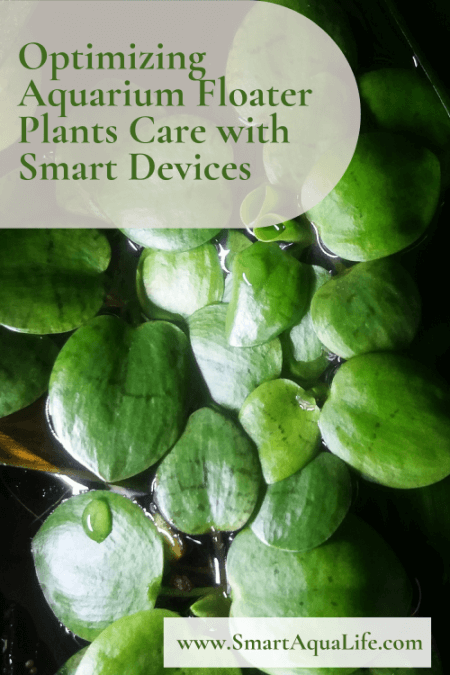
Maintaining your smart aquarium and ensuring the health of your floater plants can be a seamless process with the right approach. First and foremost, regularly check your smart devices to ensure they are functioning correctly and efficiently; this includes verifying that automated feeders, filters, and lights are on schedule. Additionally, monitor your floater plants for signs of overgrowth or nutrient deficiencies, trimming or adjusting as necessary to keep them thriving. By incorporating a routine check-up for both your smart devices and plant health, you can prevent potential issues before they arise, keeping your aquarium ecosystem vibrant and healthy. Embrace the convenience of smart aquarium technology and the natural beauty of floater plants for a stress-free and flourishing aquatic environment.
Regular Maintenance Tips
Consistency is key! Regularly check your smart device settings to ensure they’re optimized for your plants. Clean the devices as recommended to prevent malfunctions. For floater plants, thin them out periodically to prevent overcrowding and ensure they receive adequate light.
Troubleshooting Common Issues with Smart Devices
Encountered a glitch? First, check if the device is properly connected and powered. Update its firmware if needed, as manufacturers often release fixes for known issues. If problems persist, consult the device’s manual or reach out to customer support for guidance.
The Future of Aquarium Care with Smart Technology
The future is bright for lovers of aquarium floater plants. With advancements in AI and sensor technology, expect your aquatic garden to become more self-sufficient. Picture a world where your aquarium understands the needs of your floater plants, adjusting lighting and nutrients automatically. This isn’t just a dream—the technology is on its way to make our aquariums smarter, more efficient, and a haven for plants and fish alike.
Conclusion:
Investing in aquarium floater plants and smart devices is a decision that can significantly elevate the health and management of your aquarium ecosystem. The synergy between the natural efficiency of floater plants in purifying water and the precision of smart devices in maintaining optimal conditions creates an unparalleled aquatic environment. Floater plants, with their unique ability to absorb excess nutrients and reduce algae growth, work hand in hand with smart devices that automate lighting, temperature, and nutrient distribution. This combination not only showcases the lush beauty of your aquatic plants but also ensures a stable and thriving habitat for all your tank inhabitants.
Embracing smart aquarium technology alongside the addition of floater plants transforms the task of aquarium maintenance from a routine chore into a hassle-free experience. Smart devices remove the guesswork and constant monitoring traditionally associated with aquarium care, allowing you more time to enjoy the beauty of your aquatic garden. The result is a more vibrant, healthy aquarium that thrives with minimal intervention. By making this investment, you’re not just improving the quality of life for your aquatic friends; you’re also enhancing your own enjoyment and satisfaction with the hobby. Let the combination of nature and technology lead the way to a more rewarding and effortlessly managed aquarium.
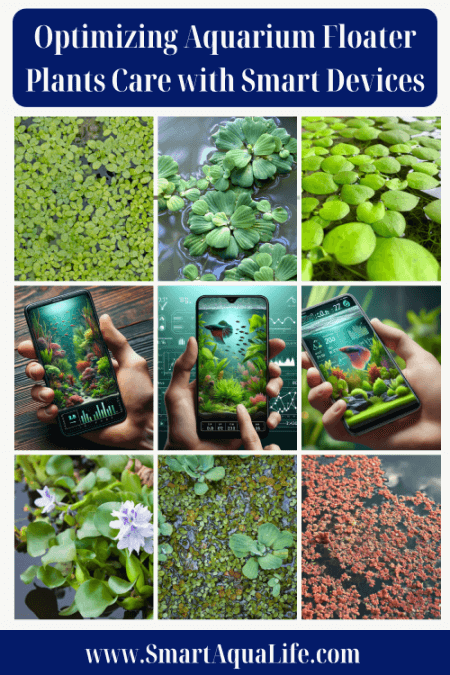
FAQs
FAQ 1: How Can Smart Technology Benefit Aquarium Floater Plants?
Smart aquarium technology, such as automated lighting systems and nutrient dosers, can significantly enhance the growth and health of your aquarium floater plants. By providing the optimal light spectrum and feeding schedules, these smart devices ensure your plants thrive, making your aquarium more vibrant and healthier.
FAQ 2: Can Smart Devices Help Control the Growth of Floater Plants?
Absolutely! With smart devices like programmable light timers and nutrient dosers, you can manage the growth rate of your floater plants more effectively. Controlling light exposure and nutrient levels prevents overgrowth, ensuring your floater plants don’t cover the entire water surface and block light to submerged plants.
FAQ 3: Are There Smart Solutions for Maintaining Water Quality With Floater Plants?
Yes, there are several smart gadgets designed to monitor and maintain water quality, crucial for both your fish and floater plants. Smart water quality monitors track parameters such as pH, temperature, and nutrient levels in real-time, sending alerts to your phone if any values stray from the ideal range. This way, you can adjust conditions before they affect plant health.
FAQ 4: How Do I Choose the Right Floater Plants for a Smart Aquarium Setup?
When choosing floater plants for a smart aquarium, consider the specific conditions and capabilities of your setup. Look for plants that match your tank’s temperature range and lighting conditions. Utilize smart technology to research plant needs and compatibility with your aquatic residents. Engaging with online communities or using aquarium management apps can also provide personalized recommendations.
FAQ 5: What Maintenance Tips Should I Follow for Floater Plants in a Smart Aquarium?
For maintaining floater plants in a smart aquarium, regular checks are still essential despite the automation. Use smart sensors to monitor water quality and adjust your maintenance schedule accordingly. Thin out your floater plants regularly to avoid overcrowding and ensure even distribution of light and nutrients. Additionally, keep your smart devices clean and functioning correctly to support the overall health of your aquarium ecosystem. By integrating smart aquarium technology with the natural benefits of floater plants, you can create a thriving, low-maintenance aquatic environment. Whether you’re a seasoned aquarist or just starting, embracing this combination can make aquarium care both enjoyable and rewarding.

